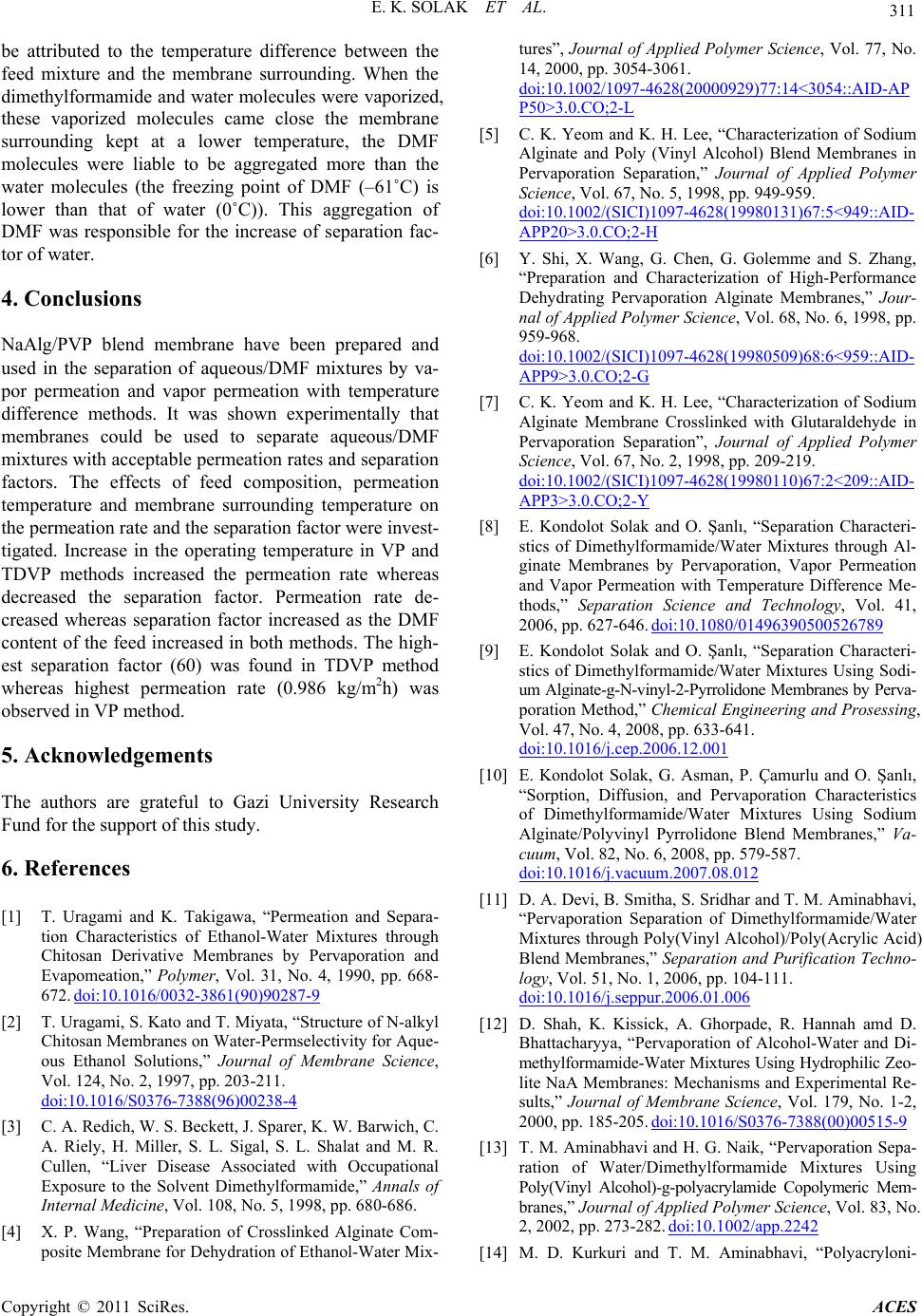
E. K. SOLAK ET AL.
311
be attributed to the temperature difference between the
feed mixture and the membrane surrounding. When the
dimethylformamide and water molecules were vaporized,
these vaporized molecules came close the membrane
surrounding kept at a lower temperature, the DMF
molecules were liable to be aggregated more than the
water molecules (the freezing point of DMF (–61˚C) is
lower than that of water (0˚C)). This aggregation of
DMF was responsible for the increase of separation fac-
tor of water.
4. Conclusions
NaAlg/PVP blend membrane have been prepared and
used in the separation of aqueous/DMF mixtures by va-
por permeation and vapor permeation with temperature
difference methods. It was shown experimentally that
membranes could be used to separate aqueous/DMF
mixtures with acceptable permeation rates and separation
factors. The effects of feed composition, permeation
temperature and membrane surrounding temperature on
the permeation rate and the separation factor were invest-
tigated. Increase in the operating temperature in VP and
TDVP methods increased the permeation rate whereas
decreased the separation factor. Permeation rate de-
creased whereas separation factor increased as the DMF
content of the feed increased in both methods. The high-
est separation factor (60) was found in TDVP method
whereas highest permeation rate (0.986 kg/m2h) was
observed in VP method.
5. Acknowledgements
The authors are grateful to Gazi University Research
Fund for the support of this study.
6. References
[1] T. Uragami and K. Takigawa, “Permeation and Separa-
tion Characteristics of Ethanol-Water Mixtures through
Chitosan Derivative Membranes by Pervaporation and
Evapomeation,” Polymer, Vol. 31, No. 4, 1990, pp. 668-
672. doi:10.1016/0032-3861(90)90287-9
[2] T. Uragami, S. Kato and T. Miyata, “Structure of N-alkyl
Chitosan Membranes on Water-Permselectivity for Aque-
ous Ethanol Solutions,” Journal of Membrane Science,
Vol. 124, No. 2, 1997, pp. 203-211.
doi:10.1016/S0376-7388(96)00238-4
[3] C. A. Redich, W. S. Beckett, J. Sparer, K. W. Barwich, C.
A. Riely, H. Miller, S. L. Sigal, S. L. Shalat and M. R.
Cullen, “Liver Disease Associated with Occupational
Exposure to the Solvent Dimethylformamide,” Annals of
Internal Medicine, Vol. 108, No. 5, 1998, pp. 680-686.
[4] X. P. Wang, “Preparation of Crosslinked Alginate Com-
posite Membrane for Dehydration of Ethanol-Water Mix-
tures”, Journal of Applied Polymer Science, Vol. 77, No.
14, 2000, pp. 3054-3061.
doi:10.1002/1097-4628(20000929)77:14<3054::AID-AP
P50>3.0.CO;2-L
[5] C. K. Yeom and K. H. Lee, “Characterization of Sodium
Alginate and Poly (Vinyl Alcohol) Blend Membranes in
Pervaporation Separation,” Journal of Applied Polymer
Science, Vol. 67, No. 5, 1998, pp. 949-959.
doi:10.1002/(SICI)1097-4628(19980131)67:5<949::AID-
APP20>3.0.CO;2-H
[6] Y. Shi, X. Wang, G. Chen, G. Golemme and S. Zhang,
“Preparation and Characterization of High-Performance
Dehydrating Pervaporation Alginate Membranes,” Jour-
nal of Applied Polymer Science, Vol. 68, No. 6, 1998, pp.
959-968.
doi:10.1002/(SICI)1097-4628(19980509)68:6<959::AID-
APP9>3.0.CO;2-G
[7] C. K. Yeom and K. H. Lee, “Characterization of Sodium
Alginate Membrane Crosslinked with Glutaraldehyde in
Pervaporation Separation”, Journal of Applied Polymer
Science, Vol. 67, No. 2, 1998, pp. 209-219.
doi:10.1002/(SICI)1097-4628(19980110)67:2<209::AID-
APP3>3.0.CO;2-Y
[8] E. Kondolot Solak and O. Şanlı, “Separation Characteri-
stics of Dimethylformamide/Water Mixtures through Al-
ginate Membranes by Pervaporation, Vapor Permeation
and Vapor Permeation with Temperature Difference Me-
thods,” Separation Science and Technology, Vol. 41,
2006, pp. 627-646. doi:10.1080/01496390500526789
[9] E. Kondolot Solak and O. Şanlı, “Separation Characteri-
stics of Dimethylformamide/Water Mixtures Using Sodi-
um Alginate-g-N-vinyl-2-Pyrrolidone Membranes by Perva-
poration Method,” Chemical Engineering and Prosessing,
Vol. 47, No. 4, 2008, pp. 633-641.
doi:10.1016/j.cep.2006.12.001
[10] E. Kondolot Solak, G. Asman, P. Çamurlu and O. Şanlı,
“Sorption, Diffusion, and Pervaporation Characteristics
of Dimethylformamide/Water Mixtures Using Sodium
Alginate/Polyvinyl Pyrrolidone Blend Membranes,” Va-
cuum, Vol. 82, No. 6, 2008, pp. 579-587.
doi:10.1016/j.vacuum.2007.08.012
[11] D. A. Devi, B. Smitha, S. Sridhar and T. M. Aminabhavi,
“Pervaporation Separation of Dimethylformamide/Water
Mixtures through Poly(Vinyl Alcohol)/Poly(Acrylic Acid)
Blend Membranes,” Separation and Purification Techno-
logy, Vol. 51, No. 1, 2006, pp. 104-111.
doi:10.1016/j.seppur.2006.01.006
[12] D. Shah, K. Kissick, A. Ghorpade, R. Hannah amd D.
Bhattacharyya, “Pervaporation of Alcohol-Water and Di-
methylformamide-Water Mixtures Using Hydrophilic Zeo-
lite NaA Membranes: Mechanisms and Experimental Re-
sults,” Journal of Membrane Science, Vol. 179, No. 1-2,
2000, pp. 185-205. doi:10.1016/S0376-7388(00)00515-9
[13] T. M. Aminabhavi and H. G. Naik, “Pervaporation Sepa-
ration of Water/Dimethylformamide Mixtures Using
Poly(Vinyl Alcohol)-g-polyacrylamide Copolymeric Mem-
branes,” Journal of Applied Polymer Science, Vol. 83, No.
2, 2002, pp. 273-282. doi:10.1002/app.2242
[14] M. D. Kurkuri and T. M. Aminabhavi, “Polyacryloni-
Copyright © 2011 SciRes. ACES